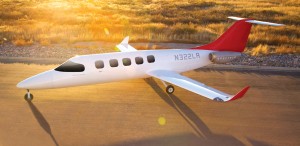By S. Clayton Moore
Spectrum Aeronautical, founded by aviation visionary Linden Blue, suffered a devastating setback when its prototype Spectrum 33 twinjet crashed during a test flight on July 25 in Utah. The fatal crash took the lives of Spectrum pilots Glenn Maben, director of flight operations for the California-based company, and Nathan Forrest, vice director of flight operations.
Both men had relocated in the past few months from Colorado to Utah to work on the project.

The sole prototype of the Spectrum 33, a cutting-edge light business jet designed by Spectrum Aeronautical and Rocky Mountain Composites, crashed on takeoff on July 25.
“It was a test flight,” said Austin Blue, son of Linden Blue and president of Spectrum Aeronautical. “We’ve had many test flights. I don’t know what went wrong with this one. Glenn and Nathan were two of the finest gentlemen and pilots. Their loss is a great tragedy.”
The nine-person light business jet crashed at Spanish Fork Airport (U77) near Provo, Utah, at about 4 p.m., on Tuesday, July 25, while on the way to EAA AirVenture Oshkosh. The Spectrum 33 had just lifted off when the right wing dipped and tapped the tarmac. At that point, the light weight of the aircraft may have worked against it, cart-wheeling it on its wings off the runway and into a field. Upon crashing, the plane stirred up a large dust cloud that caused some onlookers to believe the Spectrum had burst into flames. The plane didn’t ignite, although an unknown quantity of jet fuel was spilled onto the runway.
“It would’ve been very hard to survive that kind of crash,” said Carl Johnson, Spanish Fork police lieutenant.
The Federal Aviation Administration, National Transportation Safety Board, Utah County Sheriff’s Office, Orem Hazardous Materials Team, Spanish Fork Police and Fire Departments and the Environmental Protection Agency were called in to investigate the accident. Spectrum Aeronautical also launched its own internal investigatory team, led by corporate officer Scott Wood of Rocky Mountain Composites, a partner in the Spectrum 33 project.

Linden Blue and his son, Austin Blue, first unveiled the $3.65 million Spectrum 33 at last year’s NBAA conference in Orlando, Fla.
“We’re deeply saddened by this loss, and our thoughts and prayers are with the families of both the pilot and the copilot,” Wood said in a written statement. “We’ve activated our accident response team and are working with investigatory authorities to determine the cause of the accident.”
The $3.65 million Spectrum 33 that crashed was the sole prototype aircraft produced by Spectrum Aeronautical and was the result of more than five years of research, development and innovation by a dedicated team of aeronautical engineers. The aircraft has been developed in a joint venture between Spectrum Aeronautical and Utah-based Rocky Mountain Composites, Inc.
Spectrum employs about 80 people in Spanish Fork, south of Provo, Utah. Boasting twin Williams engines, the Spectrum is unique among its competitors with a lightweight construction totaling about 7,300 pounds at takeoff—about 6,000 pounds lighter than most of its competitors—and a body composed of a single piece of carbon-composite material, RMC’s proprietary FibeX. It was designed to reach top speeds of 415 knots, a nonstop range of 2,000 nautical miles and reach a cruising altitude of 45,000 feet.
The project originated in the early 1980s when Linden Blue, who conceived the original fabrication design, began collaborating with Larry Ashton, chairman of Rocky Mountain Composites. Its existence was first confirmed last November at the NBAA Conference in Orlando, Fla. Linden Blue had high hopes for his VLJ entry.
The aircraft had already had several successful test flights, culminating in its first public event on Friday, June 30, 2006, at the Spanish Fork Airport, when the six-year project was publicly unveiled for the first time. The test pilots for that 15-minute inaugural public flight were Maben and Forrest. The event was a remarkable achievement for Spectrum, Rocky Mountain and for the Utah aviation industry at large, drawing the praise of Utah Governor Jon M. Huntsman, who called the jet an example for aviation experts worldwide and predicting that the technology will attract more aerospace industry to Utah.
Austin Blue said it was too early to know the accident’s impact on the project’s progress. There were no initial indications of what caused the prototype airplane to crash. Prior to the accident, the aircraft was expected to be certified by the FAA by late 2007 or early 2008.
“This was the only one,” Blue said. “We have to determine what went wrong.”
PS. The NTSB released their findings soon after this story was published. The NTSB found that the ailerons were hooked up backwards during maintenance.











